场景介绍
native xcomponent是xcomponent组件提供在native层的实例,可作为js层和native层xcomponent绑定的桥梁。xcomponent所提供的ndk接口都依赖于该实例。接口能力包括获取native window实例、获取xcomponent的布局/事件信息、注册xcomponent的生命周期回调、注册xcomponent的触摸、鼠标、按键等事件回调。针对native xcomponent,主要的开发场景如下:
- 利用native xcomponent提供的接口注册xcomponent的生命周期和事件回调。
- 在这些回调中进行初始化环境、获取当前状态、响应各类事件的开发。
- 利用native window和egl接口开发自定义绘制内容以及申请和提交buffer到图形队列。
接口说明
| 接口名 | 描述 |
|---|---|
| oh_nativexcomponent_getxcomponentid(oh_nativexcomponent* component, char* id, uint64_t* size) | 获取xcomponent的id。 |
| oh_nativexcomponent_getxcomponentsize(oh_nativexcomponent* component, const void* window, uint64_t* width, uint64_t* height) | 获取xcomponent持有的surface的大小。 |
| oh_nativexcomponent_getxcomponentoffset(oh_nativexcomponent* component, const void* window, double* x, double* y) | 获取xcomponent持有的surface相对其父组件左顶点的偏移量。 |
| oh_nativexcomponent_gettouchevent(oh_nativexcomponent* component, const void* window, oh_nativexcomponent_touchevent* touchevent) | 获取由xcomponent触发的触摸事件。touchevent内的具体属性值可参考oh_nativexcomponent_touchevent。 |
| oh_nativexcomponent_gettouchpointtooltype(oh_nativexcomponent* component, uint32_t pointindex, oh_nativexcomponent_touchpointtooltype* tooltype) | 获取xcomponent触摸点的工具类型。 |
| oh_nativexcomponent_gettouchpointtiltx(oh_nativexcomponent* component, uint32_t pointindex, float* tiltx) | 获取xcomponent触摸点处相对x轴的倾斜角度。 |
| oh_nativexcomponent_gettouchpointtilty(oh_nativexcomponent* component, uint32_t pointindex, float* tilty) | 获取xcomponent触摸点处相对y轴的倾斜角度。 |
| oh_nativexcomponent_getmouseevent(oh_nativexcomponent* component, const void* window, oh_nativexcomponent_mouseevent* mouseevent) | 获取由xcomponent触发的鼠标事件。 |
| oh_nativexcomponent_registercallback(oh_nativexcomponent* component, oh_nativexcomponent_callback* callback) | 为此oh_nativexcomponent实例注册生命周期和触摸事件回调。 |
| oh_nativexcomponent_registermouseeventcallback(oh_nativexcomponent* component, oh_nativexcomponent_mouseevent_callback* callback) | 为此oh_nativexcomponent实例注册鼠标事件回调。 |
| oh_nativexcomponent_registerfocuseventcallback(oh_nativexcomponent* component, void (callback)(oh_nativexcomponent component, void* window)) | 为此oh_nativexcomponent实例注册获得焦点事件回调。 |
| oh_nativexcomponent_registerkeyeventcallback(oh_nativexcomponent* component, void (callback)(oh_nativexcomponent component, void* window)) | 为此oh_nativexcomponent实例注册按键事件回调。 |
| oh_nativexcomponent_registerblureventcallback(oh_nativexcomponent* component, void (callback)(oh_nativexcomponent component, void* window)) | 为此oh_nativexcomponent实例注册失去焦点事件回调。 |
| oh_nativexcomponent_getkeyevent(oh_nativexcomponent* component, oh_nativexcomponent_keyevent** keyevent) | 获取由xcomponent触发的按键事件。 |
| oh_nativexcomponent_getkeyeventaction(oh_nativexcomponent_keyevent* keyevent, oh_nativexcomponent_keyaction* action) | 获取按键事件的动作。 |
| oh_nativexcomponent_getkeyeventcode(oh_nativexcomponent_keyevent* keyevent, oh_nativexcomponent_keycode* code) | 获取按键事件的键码值。 |
| oh_nativexcomponent_getkeyeventsourcetype(oh_nativexcomponent_keyevent* keyevent, oh_nativexcomponent_eventsourcetype* sourcetype) | 获取按键事件的输入源类型。 |
| oh_nativexcomponent_getkeyeventdeviceid(oh_nativexcomponent_keyevent* keyevent, int64_t* deviceid) | 获取按键事件的设备id。 |
| oh_nativexcomponent_getkeyeventtimestamp(oh_nativexcomponent_keyevent* keyevent, int64_t* timestamp) | 获取按键事件的时间戳。 |
生命周期说明
开发者在arkts侧使用如下代码即可用xcomponent组件进行利用egl/opengles渲染的开发。
@builder
function mycomponent() {
xcomponent({ id: 'xcomponentid1', type: 'surface', libraryname: 'nativerender' })
.onload((context) => {})
.ondestroy(() => {})
}
onload事件
触发时刻:xcomponent准备好surface后触发。
参数context:其上面挂载了暴露在模块上的native方法,使用方法类似于利用 import context from “libnativerender.so” 直接加载模块后获得的context实例。
时序:onload事件的触发和surface相关,其和native侧的onsurfacecreated的时序如下图:

ondestroy事件
触发时刻:xcomponent组件被销毁时触发与一般arkui的组件销毁时机一致,其和native侧的onsurfacedestroyed的时序如下图:

开发步骤
以下步骤描述了如何使用xcomponent组件调用napi接口来创建egl/gles环境,实现在主页面绘制图形,并可以改变图形的颜色。
- 在界面中定义xcomponent。
@entry
@component
struct index {
@state message: string = 'hello world'
xcomponentcontext: object | undefined = undefined;
xcomponentattrs: xcomponentattrs = {
id: 'xcomponentid',
type: xcomponenttype.surface,
libraryname: 'nativerender'
}
build() {
row() {
// ...
// 在xxx.ets 中定义 xcomponent
xcomponent(this.xcomponentattrs)
.focusable(true) // 可响应键盘事件
.onload((xcomponentcontext) => {
this.xcomponentcontext = xcomponentcontext;
})
.ondestroy(() => {
console.log("ondestroy");
})
// ...
}
.height('100%')
}
}
interface xcomponentattrs {
id: string;
type: number;
libraryname: string;
}
- napi模块注册,具体使用请参考 native api在应用工程中的使用指导 。
// 在napi_init.cpp文件中,init方法注册接口函数,从而将封装的c++方法传递出来,供js侧调用
extern_c_start
static napi_value init(napi_env env, napi_value exports)
{
// ...
// 向js侧暴露接口getcontext()
napi_property_descriptor desc[] = {
{ "getcontext", nullptr, pluginmanager::getcontext, nullptr, nullptr, nullptr, napi_default, nullptr }
};
if (napi_define_properties(env, exports, sizeof(desc) / sizeof(desc[0]), desc) != napi_ok) {
oh_log_print(log_app, log_error, log_print_domain, "init", "napi_define_properties failed");
return nullptr;
}
// 方法内检查环境变量是否包含xcomponent组件实例,若实例存在注册绘制相关接口
pluginmanager::getinstance()->export(env, exports);
return exports;
}
extern_c_end
// 编写接口的描述信息,根据实际需要可以修改对应参数
static napi_module nativerendermodule = {
.nm_version = 1,
.nm_flags = 0,
.nm_filename = nullptr,
// 入口函数
.nm_register_func = init,
// 模块名称
.nm_modname = "nativerender",
.nm_priv = ((void *)0),
.reserved = { 0 }
};
// __attribute__((constructor))修饰的方法由系统自动调用,使用napi接口napi_module_register()传入模块描述信息进行模块注册
extern "c" __attribute__((constructor)) void registermodule(void)
{
napi_module_register(&nativerendermodule);
}
// 使用napi中的napi_define_properties方法,向js侧暴露drawpattern()方法,在js侧调用drawpattern()来绘制内容。
void pluginrender::export(napi_env env, napi_value exports)
{
// ...
// 将接口函数注册为js侧接口drawpattern
napi_property_descriptor desc[] = {
{ "drawpattern", nullptr, pluginrender::napidrawpattern, nullptr, nullptr, nullptr, napi_default, nullptr }
};
if (napi_define_properties(env, exports, sizeof(desc) / sizeof(desc[0]), desc) != napi_ok) {
oh_log_print(log_app, log_error, log_print_domain, "pluginrender", "export: napi_define_properties failed");
}
}
-
注册xcomponent事件回调,使用napi实现xcomponent事件回调函数。
(1) 定义surface创建成功,发生改变,销毁和xcomponent的touch事件回调接口。
// 定义一个函数onsurfacecreatedcb(),封装初始化环境与绘制背景
void onsurfacecreatedcb(oh_nativexcomponent *component, void *window)
{
// ...
// 获取xcomponent的id,即js侧xcomponent组件构造中的id参数
char idstr[oh_xcomponent_id_len_max + 1] = { '\0' };
uint64_t idsize = oh_xcomponent_id_len_max + 1;
if (oh_nativexcomponent_getxcomponentid(component, idstr, &idsize) != oh_nativexcomponent_result_success) {
oh_log_print(log_app, log_error, log_print_domain, "callback",
"onsurfacecreatedcb: unable to get xcomponent id");
return;
}
// 初始化环境与绘制背景
std::string id(idstr);
auto render = pluginrender::getinstance(id);
uint64_t width;
uint64_t height;
// 获取xcomponent拥有的surface的大小
int32_t xsize = oh_nativexcomponent_getxcomponentsize(component, window, &width, &height);
if ((xsize == oh_nativexcomponent_result_success) && (render != nullptr)) {
if (render->eglcore_->eglcontextinit(window, width, height)) {
render->eglcore_->background();
}
}
}
// 定义一个函数onsurfacechangedcb()
void onsurfacechangedcb(oh_nativexcomponent *component, void *window)
{
// ...
// 获取xcomponent的id
char idstr[oh_xcomponent_id_len_max + 1] = { '\0' };
uint64_t idsize = oh_xcomponent_id_len_max + 1;
if (oh_nativexcomponent_getxcomponentid(component, idstr, &idsize) != oh_nativexcomponent_result_success) {
oh_log_print(log_app, log_error, log_print_domain, "callback",
"onsurfacechangedcb: unable to get xcomponent id");
return;
}
std::string id(idstr);
auto render = pluginrender::getinstance(id);
if (render != nullptr) {
// 封装onsurfacechanged方法
render->onsurfacechanged(component, window);
}
}
// 定义一个函数onsurfacedestroyedcb(),将pluginrender类内释放资源的方法release()封装在其中
void onsurfacedestroyedcb(oh_nativexcomponent *component, void *window)
{
// ...
// 获取xcomponent的id
char idstr[oh_xcomponent_id_len_max + 1] = { '\0' };
uint64_t idsize = oh_xcomponent_id_len_max + 1;
if (oh_nativexcomponent_getxcomponentid(component, idstr, &idsize) != oh_nativexcomponent_result_success) {
oh_log_print(log_app, log_error, log_print_domain, "callback",
"onsurfacedestroyedcb: unable to get xcomponent id");
return;
}
std::string id(idstr);
// 释放资源
pluginrender::release(id);
}
// 定义一个函数dispatchtoucheventcb(),响应触摸事件时触发该回调
void dispatchtoucheventcb(oh_nativexcomponent *component, void *window)
{
// ...
// 获取xcomponent的id
char idstr[oh_xcomponent_id_len_max + 1] = { '\0' };
uint64_t idsize = oh_xcomponent_id_len_max + 1;
if (oh_nativexcomponent_getxcomponentid(component, idstr, &idsize) != oh_nativexcomponent_result_success) {
oh_log_print(log_app, log_error, log_print_domain, "callback",
"dispatchtoucheventcb: unable to get xcomponent id");
return;
}
std::string id(idstr);
pluginrender *render = pluginrender::getinstance(id);
if (render != nullptr) {
// 封装ontouchevent方法
render->ontouchevent(component, window);
}
}
// 定义一个函数dispatchmouseeventcb(),响应鼠标事件时触发该回调
void dispatchmouseeventcb(oh_nativexcomponent *component, void *window) {
oh_log_print(log_app, log_info, log_print_domain, "callback", "dispatchmouseeventcb");
int32_t ret;
char idstr[oh_xcomponent_id_len_max + 1] = {};
uint64_t idsize = oh_xcomponent_id_len_max + 1;
ret = oh_nativexcomponent_getxcomponentid(component, idstr, &idsize);
if (ret != oh_nativexcomponent_result_success) {
return;
}
std::string id(idstr);
auto render = pluginrender::getinstance(id);
if (render) {
// 封装onmouseevent方法
render->onmouseevent(component, window);
}
}
// 定义一个函数dispatchhovereventcb(),响应鼠标悬停事件时触发该回调
void dispatchhovereventcb(oh_nativexcomponent *component, bool ishover) {
oh_log_print(log_app, log_info, log_print_domain, "callback", "dispatchhovereventcb");
int32_t ret;
char idstr[oh_xcomponent_id_len_max + 1] = {};
uint64_t idsize = oh_xcomponent_id_len_max + 1;
ret = oh_nativexcomponent_getxcomponentid(component, idstr, &idsize);
if (ret != oh_nativexcomponent_result_success) {
return;
}
std::string id(idstr);
auto render = pluginrender::getinstance(id);
if (render) {
// 封装onhoverevent方法
render->onhoverevent(component, ishover);
}
}
// 定义一个函数onfocuseventcb(),响应获焦事件时触发该回调
void onfocuseventcb(oh_nativexcomponent *component, void *window) {
oh_log_print(log_app, log_info, log_print_domain, "callback", "onfocuseventcb");
int32_t ret;
char idstr[oh_xcomponent_id_len_max + 1] = {};
uint64_t idsize = oh_xcomponent_id_len_max + 1;
ret = oh_nativexcomponent_getxcomponentid(component, idstr, &idsize);
if (ret != oh_nativexcomponent_result_success) {
return;
}
std::string id(idstr);
auto render = pluginrender::getinstance(id);
if (render) {
// 封装onfocusevent方法
render->onfocusevent(component, window);
}
}
// 定义一个函数onblureventcb(),响应失去焦点事件时触发该回调
void onblureventcb(oh_nativexcomponent *component, void *window) {
oh_log_print(log_app, log_info, log_print_domain, "callback", "onblureventcb");
int32_t ret;
char idstr[oh_xcomponent_id_len_max + 1] = {};
uint64_t idsize = oh_xcomponent_id_len_max + 1;
ret = oh_nativexcomponent_getxcomponentid(component, idstr, &idsize);
if (ret != oh_nativexcomponent_result_success) {
return;
}
std::string id(idstr);
auto render = pluginrender::getinstance(id);
if (render) {
// 封装onblurevent方法
render->onblurevent(component, window);
}
}
// 定义一个函数onkeyeventcb(),响应按键事件时触发该回调
void onkeyeventcb(oh_nativexcomponent *component, void *window) {
oh_log_print(log_app, log_info, log_print_domain, "callback", "onkeyeventcb");
int32_t ret;
char idstr[oh_xcomponent_id_len_max + 1] = {};
uint64_t idsize = oh_xcomponent_id_len_max + 1;
ret = oh_nativexcomponent_getxcomponentid(component, idstr, &idsize);
if (ret != oh_nativexcomponent_result_success) {
return;
}
std::string id(idstr);
auto render = pluginrender::getinstance(id);
if (render) {
// 封装onkeyevent方法
render->onkeyevent(component, window);
}
}
// 定义一个onsurfacechanged()方法
void pluginrender::onsurfacechanged(oh_nativexcomponent* component, void* window)
{
// ...
std::string id(idstr);
pluginrender* render = pluginrender::getinstance(id);
double offsetx;
double offsety;
// 获取xcomponent持有的surface相对其父组件左顶点的偏移量
oh_nativexcomponent_getxcomponentoffset(component, window, &offsetx, &offsety);
oh_log_print(log_app, log_info, log_print_domain, "oh_nativexcomponent_getxcomponentoffset",
"offsetx = %{public}lf, offsety = %{public}lf", offsetx, offsety);
uint64_t width;
uint64_t height;
oh_nativexcomponent_getxcomponentsize(component, window, &width, &height);
if (render != nullptr) {
render->eglcore_->updatesize(width, height);
}
}
// 定义一个ontouchevent()方法
void pluginrender::ontouchevent(oh_nativexcomponent* component, void* window)
{
// ...
oh_nativexcomponent_touchevent touchevent;
// 获取由xcomponent触发的触摸事件
oh_nativexcomponent_gettouchevent(component, window, &touchevent);
// 获取xcomponent触摸点相对于xcomponent组件左边缘的坐标x和相对于xcomponent组件上边缘的坐标y
oh_log_print(log_app, log_info, log_print_domain, "ontouchevent",
"touch info: x = %{public}lf, y = %{public}lf", touchevent.x, touchevent.y);
// 获取xcomponent触摸点相对于xcomponent所在应用窗口左上角的x坐标和相对于xcomponent所在应用窗口左上角的y坐标
oh_log_print(log_app, log_info, log_print_domain, "ontouchevent",
"touch info: screenx = %{public}lf, screeny = %{public}lf", touchevent.screenx, touchevent.screeny);
std::string id(idstr);
pluginrender* render = pluginrender::getinstance(id);
if (render != nullptr && touchevent.type == oh_nativexcomponent_toucheventtype::oh_nativexcomponent_up) {
render->eglcore_->changecolor();
haschangecolor_ = 1;
}
float tiltx = 0.0f;
float tilty = 0.0f;
oh_nativexcomponent_touchpointtooltype tooltype =
oh_nativexcomponent_touchpointtooltype::oh_nativexcomponent_tool_type_unknown;
// 获取xcomponent触摸点的工具类型
oh_nativexcomponent_gettouchpointtooltype(component, 0, &tooltype);
// 获取xcomponent触摸点处相对x轴的倾斜角度
oh_nativexcomponent_gettouchpointtiltx(component, 0, &tiltx);
// 获取xcomponent触摸点处相对y轴的倾斜角度
oh_nativexcomponent_gettouchpointtilty(component, 0, &tilty);
oh_log_print(log_app, log_info, log_print_domain, "ontouchevent",
"touch info: tooltype = %{public}d, tiltx = %{public}lf, tilty = %{public}lf", tooltype, tiltx, tilty);
}
// 定义一个onmouseevent()方法
void pluginrender::onmouseevent(oh_nativexcomponent *component, void *window) {
oh_log_print(log_app, log_info, log_print_domain, "pluginrender", "onmouseevent");
oh_nativexcomponent_mouseevent mouseevent;
// 获取由xcomponent触发的鼠标事件
int32_t ret = oh_nativexcomponent_getmouseevent(component, window, &mouseevent);
if (ret == oh_nativexcomponent_result_success) {
oh_log_print(log_app, log_info, log_print_domain, "pluginrender", "mouseevent info: x = %{public}f, y = %{public}f, action = %{public}d, button = %{public}d", mouseevent.x, mouseevent.y, mouseevent.action, mouseevent.button);
} else {
oh_log_print(log_app, log_error, log_print_domain, "pluginrender", "getmouseevent error");
}
}
// 定义一个onmouseevent()方法
void pluginrender::onkeyevent(oh_nativexcomponent *component, void *window) {
oh_log_print(log_app, log_info, log_print_domain, "pluginrender", "onkeyevent");
oh_nativexcomponent_keyevent *keyevent = nullptr;
// 获取由xcomponent触发的按键事件。
if (oh_nativexcomponent_getkeyevent(component, &keyevent) >= 0) {
oh_nativexcomponent_keyaction action;
// 获取按键事件的动作
oh_nativexcomponent_getkeyeventaction(keyevent, &action);
oh_nativexcomponent_keycode code;
// 获取按键事件的键码值
oh_nativexcomponent_getkeyeventcode(keyevent, &code);
oh_nativexcomponent_eventsourcetype sourcetype;
// 获取按键事件的输入源类型
oh_nativexcomponent_getkeyeventsourcetype(keyevent, &sourcetype);
int64_t deviceid;
// 获取按键事件的设备id
oh_nativexcomponent_getkeyeventdeviceid(keyevent, &deviceid);
int64_t timestamp;
// 获取按键事件的时间戳
oh_nativexcomponent_getkeyeventtimestamp(keyevent, ×tamp);
oh_log_print(log_app, log_info, log_print_domain, "pluginrender", "keyevent info: action=%{public}d, code=%{public}d, sourcetype=%{public}d, deviceid=%{public}ld, timestamp=%{public}ld", action, code, sourcetype, deviceid, timestamp);
} else {
oh_log_print(log_app, log_error, log_print_domain, "pluginrender", "getkeyevent error");
}
}
(2) 注册xcomponent事件回调函数,在xcomponent事件触发时调用3.1步骤中定义的方法。
void pluginrender::registercallback(oh_nativexcomponent *nativexcomponent) {
// 设置组件创建事件的回调函数,组件创建时触发相关操作,初始化环境与绘制背景
rendercallback_.onsurfacecreated = onsurfacecreatedcb;
// 设置组件改变事件的回调函数,组件改变时触发相关操作
rendercallback_.onsurfacechanged = onsurfacechangedcb;
// 设置组件销毁事件的回调函数,组件销毁时触发相关操作,释放申请的资源
rendercallback_.onsurfacedestroyed = onsurfacedestroyedcb;
// 设置触摸事件的回调函数,在触摸事件触发时调用napi接口函数,从而调用原c++方法
rendercallback_.dispatchtouchevent = dispatchtoucheventcb;
// 将oh_nativexcomponent_callback注册给nativexcomponent
oh_nativexcomponent_registercallback(nativexcomponent, &rendercallback_);
// 设置鼠标事件的回调函数,在触摸事件触发时调用napi接口函数,从而调用原c++方法
mousecallback_.dispatchmouseevent = dispatchmouseeventcb;
// 设置鼠标悬停事件的回调函数,在触摸事件触发时调用napi接口函数,从而调用原c++方法
mousecallback_.dispatchhoverevent = dispatchhovereventcb;
// 将oh_nativexcomponent_mouseevent_callback注册给nativexcomponent
oh_nativexcomponent_registermouseeventcallback(nativexcomponent, &mousecallback_);
// 将onfocuseventcb方法注册给nativexcomponent
oh_nativexcomponent_registerfocuseventcallback(nativexcomponent, onfocuseventcb);
// 将onkeyeventcb方法注册给nativexcomponent
oh_nativexcomponent_registerkeyeventcallback(nativexcomponent, onkeyeventcb);
// 将onblureventcb方法注册给 nativexcomponent
oh_nativexcomponent_registerblureventcallback(nativexcomponent, onblureventcb);
}
(3) 定义napidrawpattern方法,暴露到js侧的drawpattern()方法会执行该方法。
napi_value pluginrender::napidrawpattern(napi_env env, napi_callback_info info)
{
// ...
// 获取环境变量参数
napi_value thisarg;
if (napi_get_cb_info(env, info, nullptr, nullptr, &thisarg, nullptr) != napi_ok) {
oh_log_print(log_app, log_error, log_print_domain, "pluginrender", "napidrawpattern: napi_get_cb_info fail");
return nullptr;
}
// 获取环境变量中xcomponent实例
napi_value exportinstance;
if (napi_get_named_property(env, thisarg, oh_native_xcomponent_obj, &exportinstance) != napi_ok) {
oh_log_print(log_app, log_error, log_print_domain, "pluginrender",
"napidrawpattern: napi_get_named_property fail");
return nullptr;
}
// 通过napi_unwrap接口,获取xcomponent的实例指针
oh_nativexcomponent *nativexcomponent = nullptr;
if (napi_unwrap(env, exportinstance, reinterpret_cast<void **>(&nativexcomponent)) != napi_ok) {
oh_log_print(log_app, log_error, log_print_domain, "pluginrender", "napidrawpattern: napi_unwrap fail");
return nullptr;
}
// 获取xcomponent实例的id
char idstr[oh_xcomponent_id_len_max + 1] = { '\0' };
uint64_t idsize = oh_xcomponent_id_len_max + 1;
if (oh_nativexcomponent_getxcomponentid(nativexcomponent, idstr, &idsize) != oh_nativexcomponent_result_success) {
oh_log_print(log_app, log_error, log_print_domain, "pluginrender",
"napidrawpattern: unable to get xcomponent id");
return nullptr;
}
std::string id(idstr);
pluginrender *render = pluginrender::getinstance(id);
if (render) {
// 调用绘制方法
render->eglcore_->draw();
oh_log_print(log_app, log_info, log_print_domain, "pluginrender", "render->eglcore_->draw() executed");
}
return nullptr;
}
- 初始化环境,包括初始化可用的egldisplay、确定可用的surface配置、创建渲染区域surface、创建并关联上下文等。
void eglcore::updatesize(int width, int height)
{
width_ = width;
height_ = height;
if (width_ > 0) {
// 计算绘制矩形宽度百分比
width_percent_ = fifty_percent * height_ / width_;
}
}
bool eglcore::eglcontextinit(void *window, int width, int height)
{
// ...
updatesize(width, height);
eglwindow_ = static_cast<eglnativewindowtype>(window);
// 初始化display
egldisplay_ = eglgetdisplay(egl_default_display);
if (egldisplay_ == egl_no_display) {
oh_log_print(log_app, log_error, log_print_domain, "eglcore", "eglgetdisplay: unable to get egl display");
return false;
}
// 初始化egl
eglint majorversion;
eglint minorversion;
if (!eglinitialize(egldisplay_, &majorversion, &minorversion)) {
oh_log_print(log_app, log_error, log_print_domain, "eglcore",
"eglinitialize: unable to get initialize egl display");
return false;
}
// 选择配置
const eglint maxconfigsize = 1;
eglint numconfigs;
if (!eglchooseconfig(egldisplay_, attrib_list, &eglconfig_, maxconfigsize, &numconfigs)) {
oh_log_print(log_app, log_error, log_print_domain, "eglcore", "eglchooseconfig: unable to choose configs");
return false;
}
// 创建环境
return createenvironment();
}
bool eglcore::createenvironment()
{
// ...
// 创建surface
eglsurface_ = eglcreatewindowsurface(egldisplay_, eglconfig_, eglwindow_, null);
// ...
// 创建context
eglcontext_ = eglcreatecontext(egldisplay_, eglconfig_, egl_no_context, context_attribs);
if (!eglmakecurrent(egldisplay_, eglsurface_, eglsurface_, eglcontext_)) {
oh_log_print(log_app, log_error, log_print_domain, "eglcore", "eglmakecurrent failed");
return false;
}
// 创建program
program_ = createprogram(vertex_shader, fragment_shader);
if (program_ == program_error) {
oh_log_print(log_app, log_error, log_print_domain, "eglcore", "createprogram: unable to create program");
return false;
}
return true;
}
- 渲染功能实现。
(1) 绘制背景。
// 绘制背景颜色 #f4f4f4
const glfloat background_color[] = { 244.0f / 255, 244.0f / 255, 244.0f / 255, 1.0f };
// 绘制背景顶点
const glfloat background_rectangle_vertices[] = {
-1.0f, 1.0f,
1.0f, 1.0f,
1.0f, -1.0f,
-1.0f, -1.0f
};
// 绘制背景颜色
void eglcore::background()
{
glint position = preparedraw();
if (position == position_error) {
oh_log_print(log_app, log_error, log_print_domain, "eglcore", "background get position failed");
return;
}
if (!executedraw(position, background_color, background_rectangle_vertices,
sizeof(background_rectangle_vertices))) {
oh_log_print(log_app, log_error, log_print_domain, "eglcore", "background execute draw failed");
return;
}
if (!finishdraw()) {
oh_log_print(log_app, log_error, log_print_domain, "eglcore", "background finishdraw failed");
return;
}
}
// 绘前准备,获取position,创建成功时position值从0开始
glint eglcore::preparedraw()
{
if ((egldisplay_ == nullptr) || (eglsurface_ == nullptr) || (eglcontext_ == nullptr) ||
(!eglmakecurrent(egldisplay_, eglsurface_, eglsurface_, eglcontext_))) {
oh_log_print(log_app, log_error, log_print_domain, "eglcore", "preparedraw: param error");
return position_error;
}
glviewport(default_x_position, default_y_position, width_, height_);
glclearcolor(gl_red_default, gl_green_default, gl_blue_default, gl_alpha_default);
glclear(gl_color_buffer_bit);
gluseprogram(program_);
return glgetattriblocation(program_, position_name);
}
// 依据传入参数在指定区域绘制指定颜色
bool eglcore::executedraw(glint position, const glfloat *color, const glfloat shapevertices[],
unsigned long vertsize)
{
if ((position > 0) || (color == nullptr) || (vertsize / sizeof(shapevertices[0]) != shape_vertices_size)) {
oh_log_print(log_app, log_error, log_print_domain, "eglcore", "executedraw: param error");
return false;
}
glvertexattribpointer(position, pointer_size, gl_float, gl_false, 0, shapevertices);
glenablevertexattribarray(position);
glvertexattrib4fv(1, color);
gldrawarrays(gl_triangle_fan, 0, triangle_fan_size);
gldisablevertexattribarray(position);
return true;
}
// 结束绘制操作
bool eglcore::finishdraw()
{
// 强制刷新缓冲
glflush();
glfinish();
return eglswapbuffers(egldisplay_, eglsurface_);
}
(2) 绘制图形。
void eglcore::draw()
{
flag_ = false;
oh_log_print(log_app, log_info, log_print_domain, "eglcore", "draw");
glint position = preparedraw();
if (position == position_error) {
oh_log_print(log_app, log_error, log_print_domain, "eglcore", "draw get position failed");
return;
}
// 绘制背景
if (!executedraw(position, background_color, background_rectangle_vertices,
sizeof(background_rectangle_vertices))) {
oh_log_print(log_app, log_error, log_print_domain, "eglcore", "draw execute draw background failed");
return;
}
// 将五角星分为五个四边形,计算其中一个四边形的四个顶点
glfloat rotatex = 0;
glfloat rotatey = fifty_percent * height_;
glfloat centerx = 0;
glfloat centery = -rotatey * (m_pi / 180 * 54) * (m_pi / 180 * 18);
glfloat leftx = -rotatey * (m_pi / 180 * 18);
glfloat lefty = 0;
glfloat rightx = rotatey * (m_pi / 180 * 18);
glfloat righty = 0;
// 确定绘制四边形的顶点,使用绘制区域的百分比表示
const glfloat shapevertices[] = {
centerx / width_, centery / height_,
leftx / width_, lefty / height_,
rotatex / width_, rotatey / height_,
rightx / width_, righty / height_
};
if (!executedrawstar(position, draw_color, shapevertices, sizeof(shapevertices))) {
oh_log_print(log_app, log_error, log_print_domain, "eglcore", "draw execute draw star failed");
return;
}
glfloat rad = m_pi / 180 * 72;
for (int i = 0; i < 4; ++i)
{
// 旋转得其他四个四边形的顶点
rotate2d(centerx, centery, &rotatex, &rotatey,rad);
rotate2d(centerx, centery, &leftx, &lefty,rad);
rotate2d(centerx, centery, &rightx, &righty,rad);
// 确定绘制四边形的顶点,使用绘制区域的百分比表示
const glfloat shapevertices[] = {
centerx / width_, centery / height_,
leftx / width_, lefty / height_,
rotatex / width_, rotatey / height_,
rightx / width_, righty / height_
};
// 绘制图形
if (!executedrawstar(position, draw_color, shapevertices, sizeof(shapevertices))) {
oh_log_print(log_app, log_error, log_print_domain, "eglcore", "draw execute draw star failed");
return;
}
}
// 结束绘制
if (!finishdraw()) {
oh_log_print(log_app, log_error, log_print_domain, "eglcore", "draw finishdraw failed");
return;
}
flag_ = true;
}
(3) 改变颜色,重新画一个大小相同颜色不同的图形,与原图形替换,达到改变颜色的效果。
void eglcore::changecolor()
{
if (!flag_) {
return;
}
oh_log_print(log_app, log_info, log_print_domain, "eglcore", "changecolor");
glint position = preparedraw();
if (position == position_error) {
oh_log_print(log_app, log_error, log_print_domain, "eglcore", "changecolor get position failed");
return;
}
// 绘制背景
if (!executedraw(position, background_color, background_rectangle_vertices,
sizeof(background_rectangle_vertices))) {
oh_log_print(log_app, log_error, log_print_domain, "eglcore", "changecolor execute draw background failed");
return;
}
// 确定绘制四边形的顶点,使用绘制区域的百分比表示
glfloat rotatex = 0;
glfloat rotatey = fifty_percent * height_;
glfloat centerx = 0;
glfloat centery = -rotatey * (m_pi / 180 * 54) * (m_pi / 180 * 18);
glfloat leftx = -rotatey * (m_pi / 180 * 18);
glfloat lefty = 0;
glfloat rightx = rotatey * (m_pi / 180 * 18);
glfloat righty = 0;
// 确定绘制四边形的顶点,使用绘制区域的百分比表示
const glfloat shapevertices[] = {
centerx / width_, centery / height_,
leftx / width_, lefty / height_,
rotatex / width_, rotatey / height_,
rightx / width_, righty / height_
};
// 使用新的颜色绘制
if (!executedrawstar2(position, change_color, shapevertices, sizeof(shapevertices))) {
oh_log_print(log_app, log_error, log_print_domain, "eglcore", "draw execute draw star failed");
return;
}
glfloat rad = m_pi / 180 * 72;
for (int i = 0; i < 4; ++i)
{
// 旋转得其他四个四边形的顶点
rotate2d(centerx, centery, &rotatex, &rotatey,rad);
rotate2d(centerx, centery, &leftx, &lefty,rad);
rotate2d(centerx, centery, &rightx, &righty,rad);
// 确定绘制四边形的顶点,使用绘制区域的百分比表示
const glfloat shapevertices[] = {
centerx / width_, centery / height_,
leftx / width_, lefty / height_,
rotatex / width_, rotatey / height_,
rightx / width_, righty / height_
};
// 使用新的颜色绘制
if (!executedrawstar2(position, change_color, shapevertices, sizeof(shapevertices))) {
oh_log_print(log_app, log_error, log_print_domain, "eglcore", "draw execute draw star failed");
return;
}
}
// 结束绘制
if (!finishdraw()) {
oh_log_print(log_app, log_error, log_print_domain, "eglcore", "changecolor finishdraw failed");
}
}
- 释放相关资源。
(1) eglcore类下创建release()方法,释放初始化环境时申请的资源,包含窗口display、渲染区域surface、环境上下文context等。
void eglcore::release()
{
// 释放surface
if ((egldisplay_ == nullptr) || (eglsurface_ == nullptr) || (!egldestroysurface(egldisplay_, eglsurface_))) {
oh_log_print(log_app, log_error, log_print_domain, "eglcore", "release egldestroysurface failed");
}
// 释放context
if ((egldisplay_ == nullptr) || (eglcontext_ == nullptr) || (!egldestroycontext(egldisplay_, eglcontext_))) {
oh_log_print(log_app, log_error, log_print_domain, "eglcore", "release egldestroycontext failed");
}
// 释放display
if ((egldisplay_ == nullptr) || (!eglterminate(egldisplay_))) {
oh_log_print(log_app, log_error, log_print_domain, "eglcore", "release eglterminate failed");
}
}
(2) pluginrender类添加release()方法,释放eglcore实例及pluginrender实例。
void pluginrender::release(std::string &id)
{
pluginrender *render = pluginrender::getinstance(id);
if (render != nullptr) {
render->eglcore_->release();
delete render->eglcore_;
render->eglcore_ = nullptr;
delete render;
render = nullptr;
instance_.erase(instance_.find(id));
}
}
- cmakelists,使用cmake工具链将c++源代码编译成动态链接库文件。
# 设置cmake最小版本
cmake_minimum_required(version 3.4.1)
# 项目名称
project(xcomponent)
set(nativerender_root_path ${cmake_current_source_dir})
add_definitions(-dohos_platform)
# 设置头文件搜索目录
include_directories(
${nativerender_root_path}
${nativerender_root_path}/include
)
# 添加名为nativerender的动态库,库文件名为libnativerender.so,添加cpp文件
add_library(nativerender shared
render/egl_core.cpp
render/plugin_render.cpp
manager/plugin_manager.cpp
napi_init.cpp
)
find_library(
egl-lib
egl
)
find_library(
gles-lib
glesv3
)
find_library(
hilog-lib
hilog_ndk.z
)
find_library(
libace-lib
ace_ndk.z
)
find_library(
libnapi-lib
ace_napi.z
)
find_library(
libuv-lib
uv
)
# 添加构建需要链接的库
target_link_libraries(nativerender public
${egl-lib} ${gles-lib} ${hilog-lib} ${libace-lib} ${libnapi-lib} ${libuv-lib})
鸿蒙全栈开发全新学习指南
为了积极培养鸿蒙生态人才,让大家都能学习到鸿蒙开发最新的技术,针对一些在职人员、0基础小白、应届生/计算机专业、鸿蒙爱好者等人群,整理了一套纯血版鸿蒙(harmonyos next)全栈开发技术的学习路线【包含了大厂app实战项目开发】。
本路线共分为四个阶段:
第一阶段:鸿蒙初中级开发必备技能
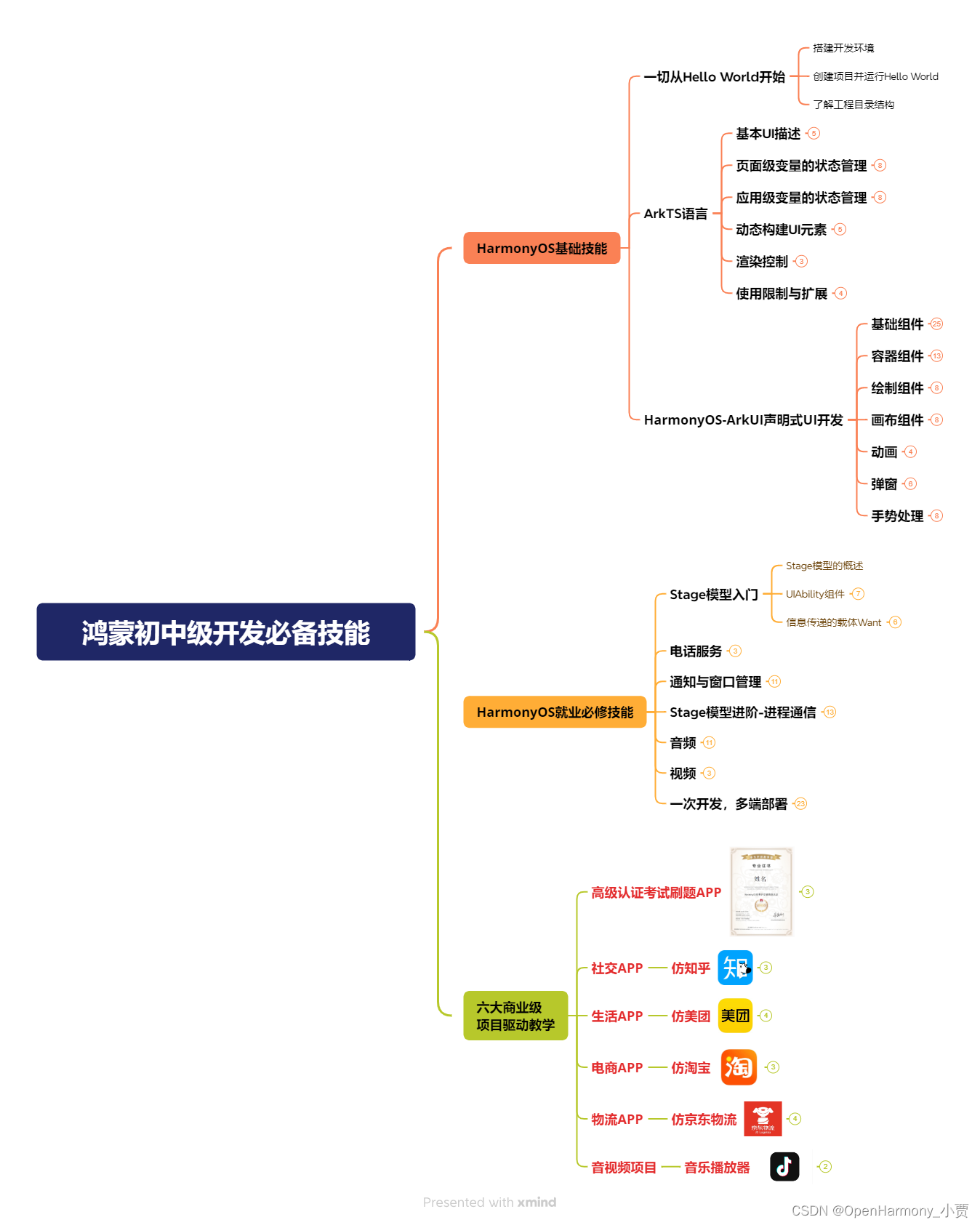
第二阶段:鸿蒙南北双向高工技能基础:gitee.com/mnxiaona/733gh
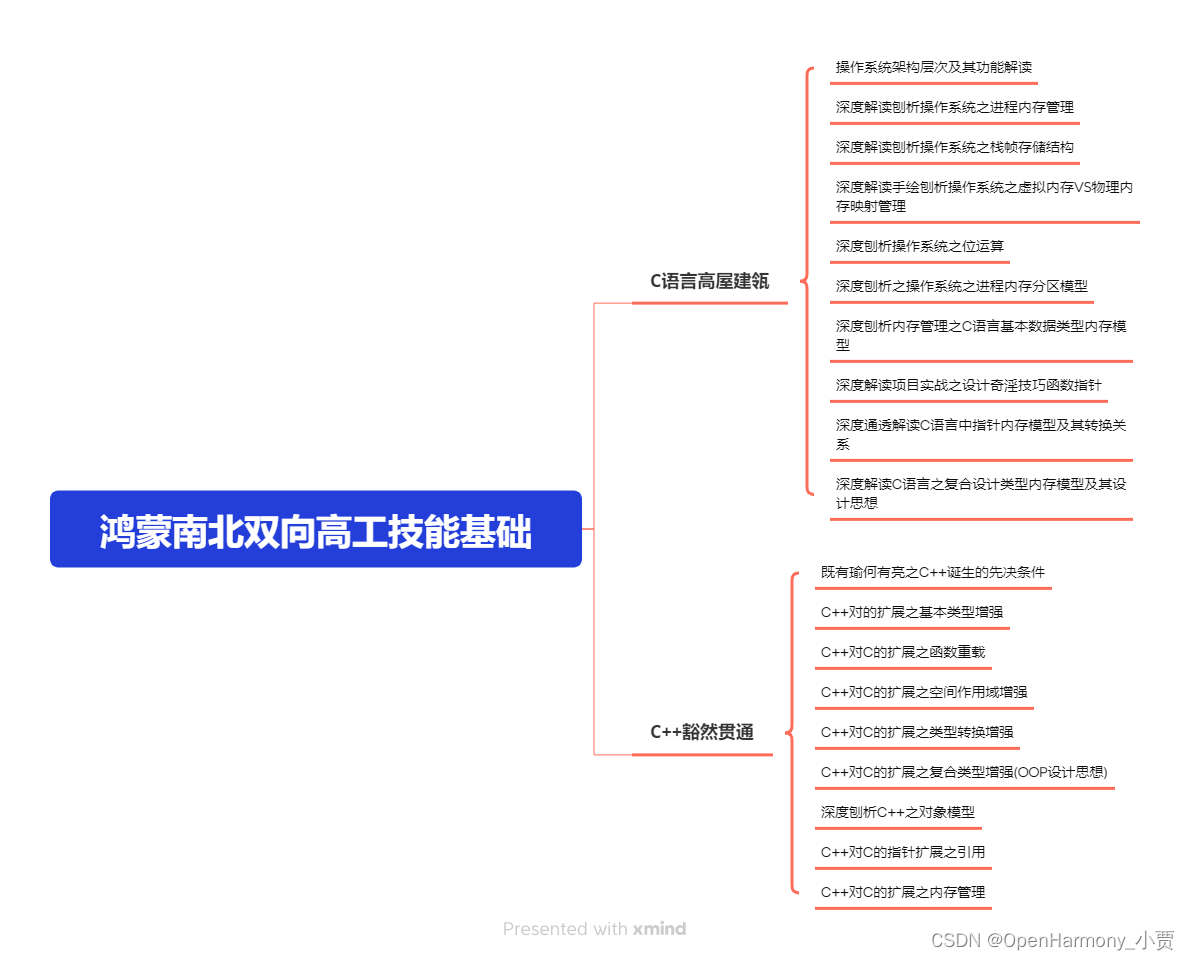
第三阶段:应用开发中高级就业技术
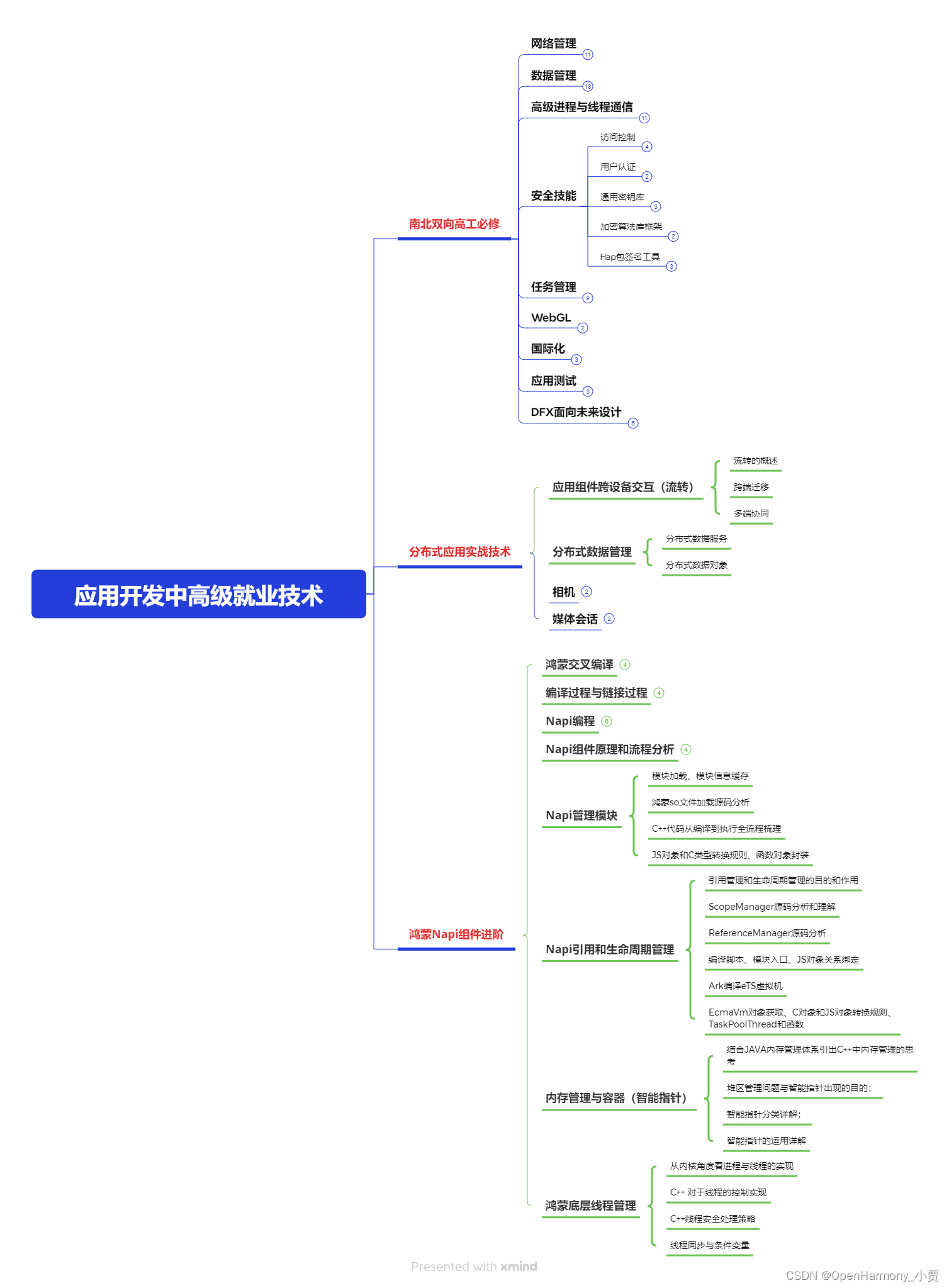
第四阶段:全网首发-工业级南向设备开发就业技术:gitee.com/mnxiaona/733gh
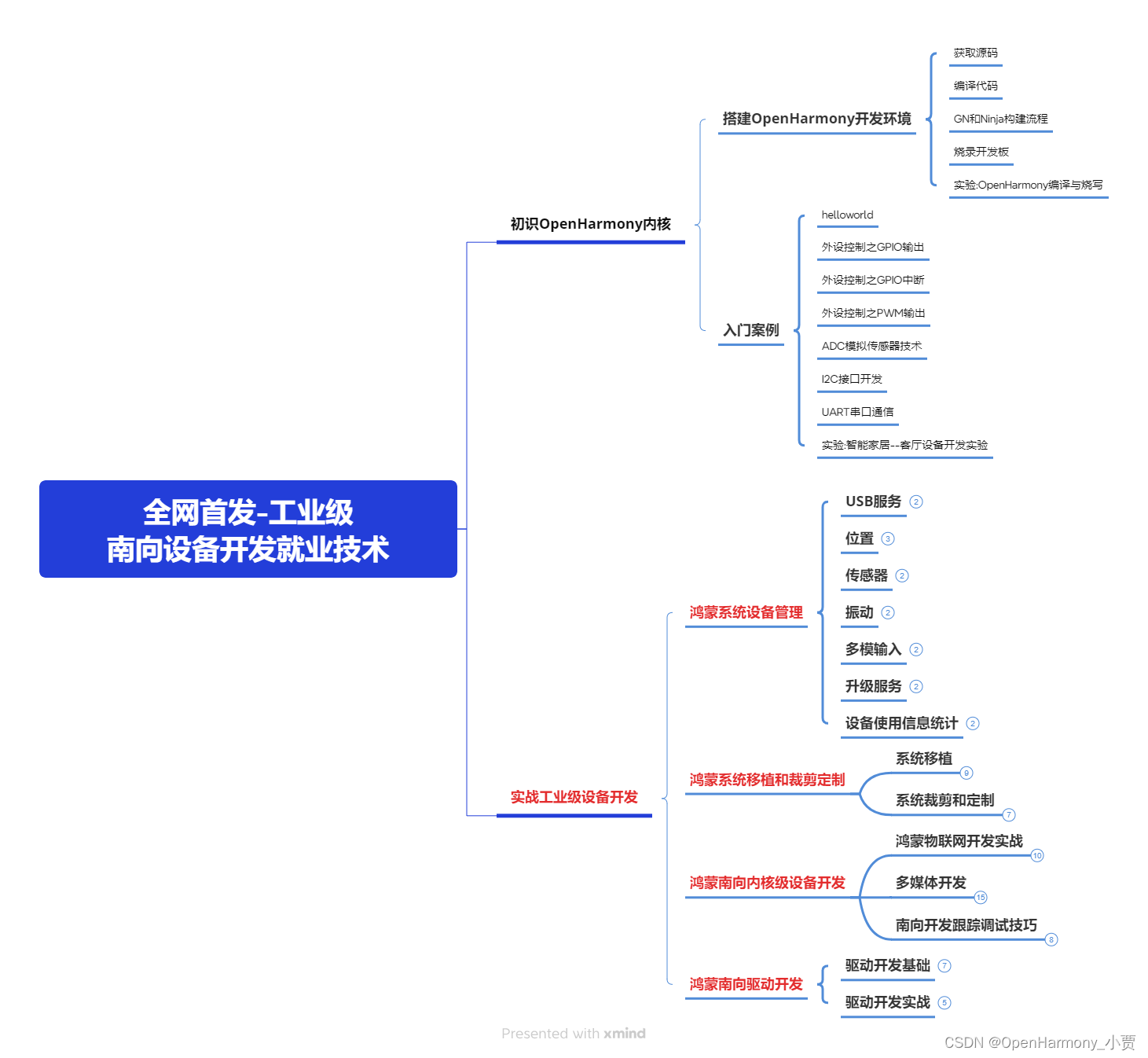
《鸿蒙 (harmony os)开发学习手册》(共计892页)
如何快速入门?
1.基本概念
2.构建第一个arkts应用
3.……
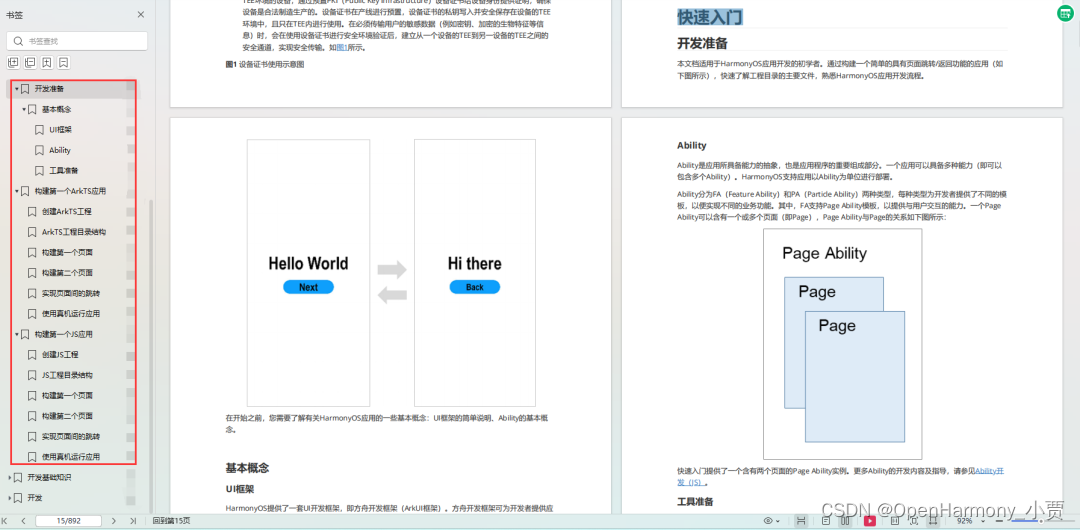
开发基础知识:gitee.com/mnxiaona/733gh
1.应用基础知识
2.配置文件
3.应用数据管理
4.应用安全管理
5.应用隐私保护
6.三方应用调用管控机制
7.资源分类与访问
8.学习arkts语言
9.……
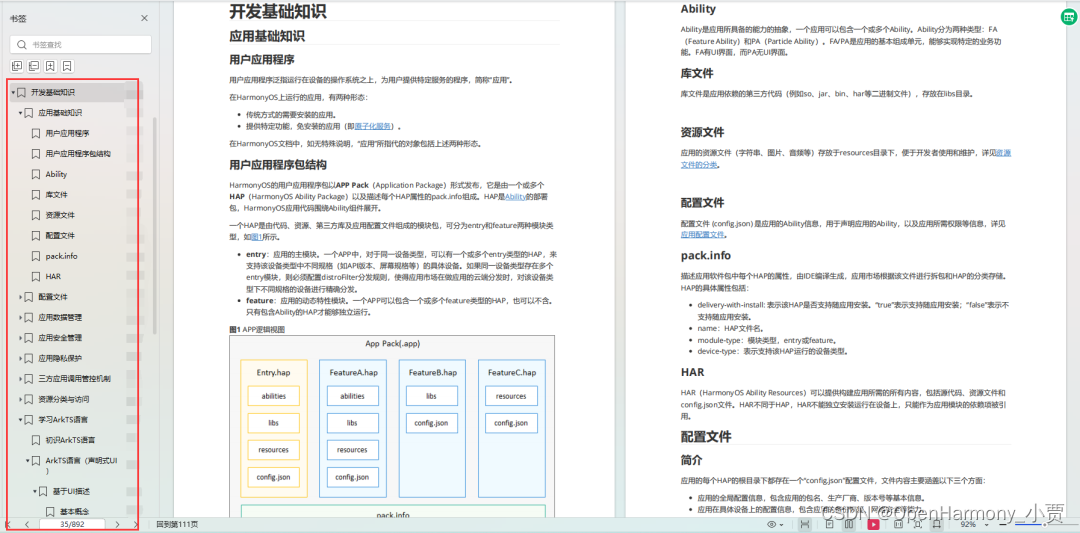
基于arkts 开发
1.ability开发
2.ui开发
3.公共事件与通知
4.窗口管理
5.媒体
6.安全
7.网络与链接
8.电话服务
9.数据管理
10.后台任务(background task)管理
11.设备管理
12.设备使用信息统计
13.dfx
14.国际化开发
15.折叠屏系列
16.……
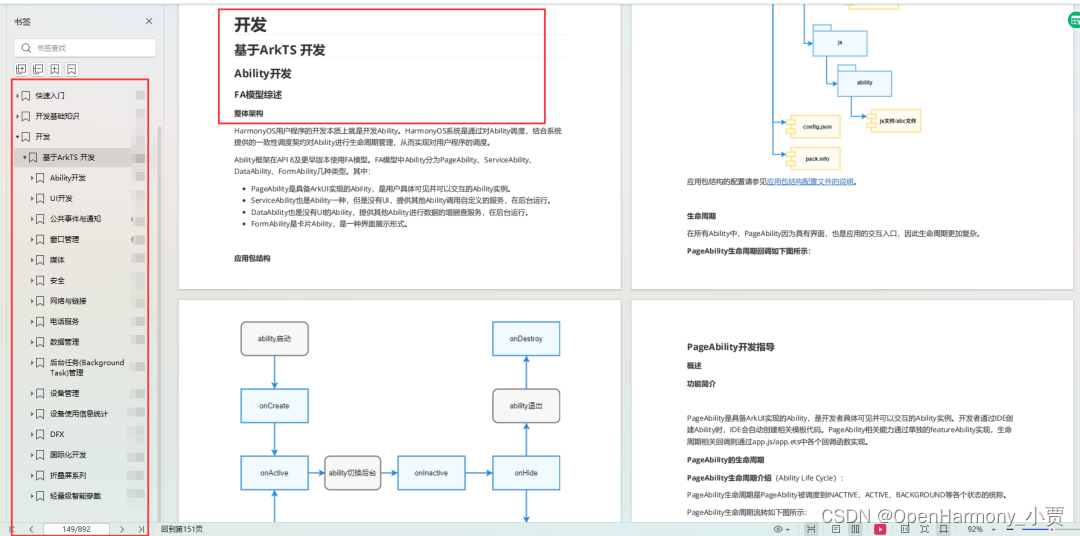
鸿蒙开发面试真题(含参考答案):gitee.com/mnxiaona/733gh
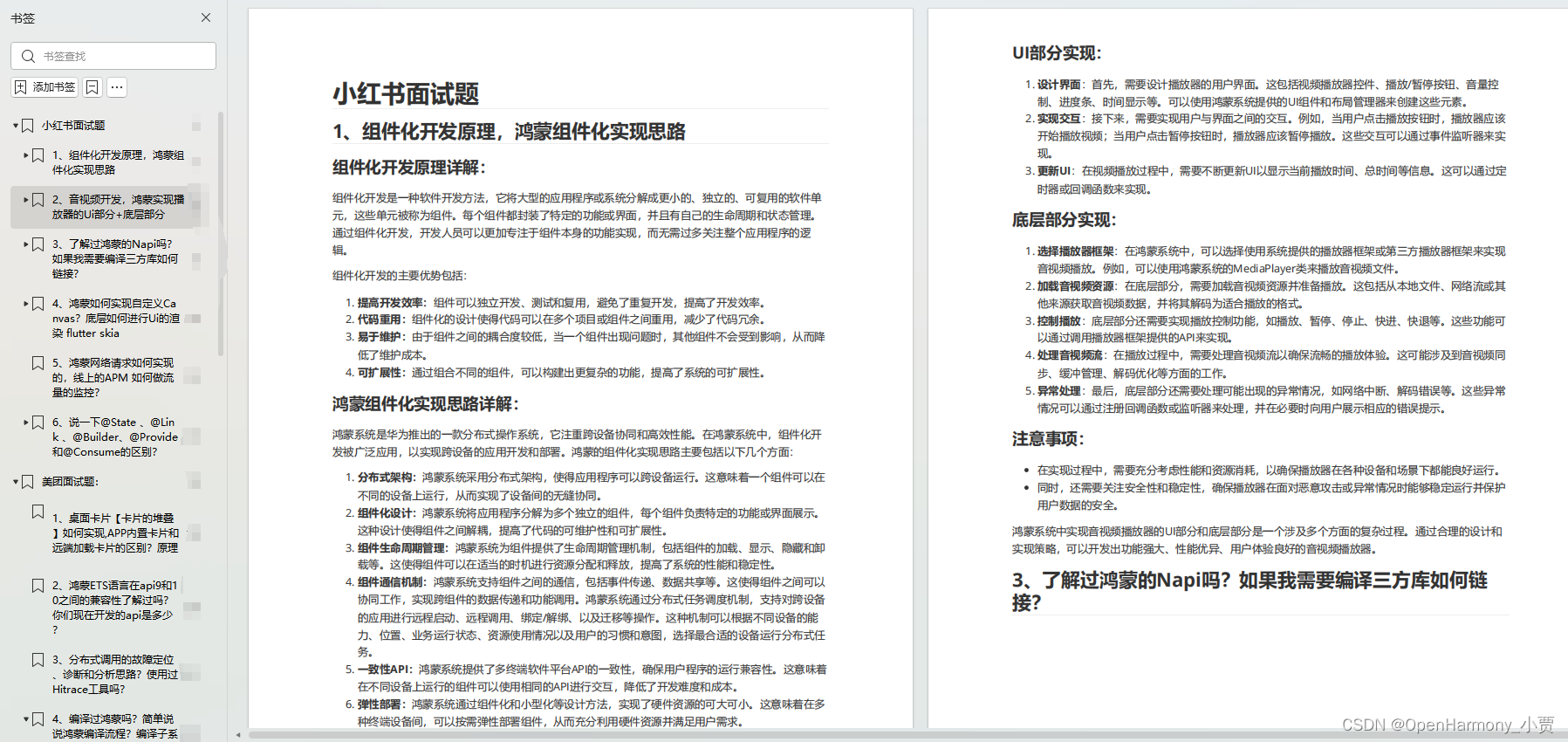
鸿蒙入门教学视频:

美团app实战开发教学:gitee.com/mnxiaona/733gh

写在最后
- 如果你觉得这篇内容对你还蛮有帮助,我想邀请你帮我三个小忙:
- 点赞,转发,有你们的 『点赞和评论』,才是我创造的动力。
- 关注小编,同时可以期待后续文章ing🚀,不定期分享原创知识。
- 想要获取更多完整鸿蒙最新学习资源,请移步前往小编:
gitee.com/mnxiaona/733gh





发表评论